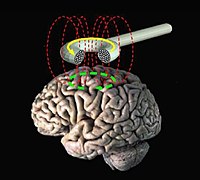
Photo from wikipedia
Repetitive transcranial magnetic stimulation (rTMS) is a noninvasive brain stimulation technique that can influence cortical excitability. Low-frequency rTMS (stimulation frequency ≤1Hz) can induce inhibitory effects on cortical excitability. In order… Click to show full abstract
Repetitive transcranial magnetic stimulation (rTMS) is a noninvasive brain stimulation technique that can influence cortical excitability. Low-frequency rTMS (stimulation frequency ≤1Hz) can induce inhibitory effects on cortical excitability. In order to investigate dynamic changes in neuronal activity after low-frequency rTMS, 20 healthy subjects received 1-Hz rTMS over the right motor area, and electroencephalography (EEG) in resting condition with eyes open was recorded before rTMS and at 0 min, 20 min, 40 min, and 60 min after rTMS. Power values, functional connectivity based on a weighted phase lag index (wPLI), and network characteristics were assessed and compared to study the aftereffects of rTMS. Our results show that low-frequency rTMS produced a delayed long-lasting increase in alpha-band power values in frontoparietal brain areas and an immediate long-lasting increase in theta-band power values in the ipsilateral frontal and contralateral centroparietal areas. In the alpha band, functional connectivity decreased immediately after rTMS but significantly increased at 20 min after rTMS. Moreover, an analysis of undirected graphs revealed that the number of connections significantly changed in the anterior and posterior regions in the alpha band. In addition, there were significant decreases in clustering coefficients of the channels near the site of stimulation in the alpha and theta bands after rTMS. In conclusion, low-frequency rTMS produces widespread and long-lasting alterations in neural oscillation and functional connectivity. This work implies that low-frequency rTMS can induce inhibitory effects on motor cortical excitability ipsilateral to the stimulation site.
Journal Title: IEEE Transactions on Neural Systems and Rehabilitation Engineering
Year Published: 2020
Link to full text (if available)
Share on Social Media: Sign Up to like & get
recommendations!